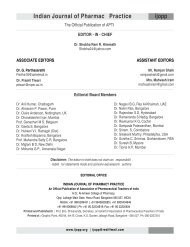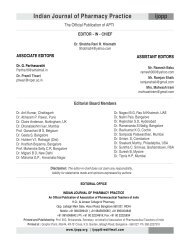APTI ijopp - Indian Journal of Pharmacy Practice
APTI ijopp - Indian Journal of Pharmacy Practice
APTI ijopp - Indian Journal of Pharmacy Practice
- No tags were found...
You also want an ePaper? Increase the reach of your titles
YUMPU automatically turns print PDFs into web optimized ePapers that Google loves.
<strong>Indian</strong> J. Pharm. Pract. 1(2), Jan-Mar, 2009involved in the management <strong>of</strong> adverse drug reaction. the suggestions provided. In few cases, experiencedAntibiotics (21%) was the most commonly implicated physician did not change their routine prescribing patterndrug class in DRPs. This observation was coinciding despite the presence <strong>of</strong> DRP, especially, DRP <strong>of</strong> 'minor'15,16with observations made by different studies. Ahuva significance. For example, a suggestion for use <strong>of</strong>15Lusting found antibiotics (38.7%) as the most prevalent domperidone instead <strong>of</strong> ondansetron for vomiting wasclass <strong>of</strong> drugs prescribed in hospital. Inappropriaterejected.antibiotic usage may provoke the emergence <strong>of</strong> bacterial The total time spent by the pharmacist in preparing,resistance and increased healthcare cost. Similar finding undertaking and documenting all interventions was 106was reported in a study conducted by Carlos Bantar ethours and 25 minutes. The average time spent for each16al . In our study, patients were either receiving high doseintervention was 12.5 minutes (range: 2 to 60 minutes).<strong>of</strong> antibiotics or antibiotics were prescribed without any 2This observation is in contrast to Michael J. Dooley et alvalid indication. Of the 261 DRPs, 17% and 15% <strong>of</strong> thestudy wherein 9.6 minutes (range: 0-60 minutes) wasDRPs were found in patients treated for cardiovascularspent for each intervention. This difference may bedisorders and respiratory disorders respectively. These2 attributed to the fact that unlike India, drug informationobservations correlated with the Michael J. Dooley et alservices and patient medication history were availablestudy conducted in Australia. In our study, it may be17perhaps due to high occupancy rate <strong>of</strong> patients withonline in developed countries like Australia . In addition,cardiovascular disorders and respiratory disorder in unlike our study, involvement <strong>of</strong> experienced clinicalmedical ward resulting in use <strong>of</strong> more medication in these pharmacist would have led to the high acceptance ratepatients, thus leading to potential DRPs. and also reduction in time spent for each intervention.Cessation <strong>of</strong> drug (20%) and addition <strong>of</strong> drug (14%) were Textbooks were found to be the most frequently (56%)the suggestions most frequently provided. This finding consulted references followed by the personal2differs from observation made in an <strong>Indian</strong> study knowledge <strong>of</strong> the intervening pharmacist in providingwherein change in drug dose was reported as the most various suggestions. As majority <strong>of</strong> DRPs were <strong>of</strong> 'minor'common suggestion made. Other suggestions made in significance, most <strong>of</strong> DRPs were managed with theour study included change in drug dose, duration <strong>of</strong> amount <strong>of</strong> information available in various textbooks.therapy, frequency <strong>of</strong> administration and substitution <strong>of</strong> The information available in textbooks is verydrug etc. Addition <strong>of</strong> drug was suggested in case <strong>of</strong> comprehensive and also covers wide ranges <strong>of</strong> diseasesuntreated indications that required treatment. Few <strong>of</strong> the and their treatment aspect. Also, since the department <strong>of</strong>untreated conditions included anemia, cough and cold. In clinical pharmacy located at JSS hospital is wellmost cases, the change in drug dose was sought inequipped with drug information resources including thepatients with renal/hepatic impairment requiring dosagelatest resources <strong>of</strong> textbooks, it was possible to obtainreduction. In our study, the major reasons for cessation <strong>of</strong>latest information required to address the DRPs.drug were due to drug use without indication andAll the 183 interventions which were accepted andimproper drug selection. Few examples that warrantedchanged by the physicians were allocated for costthe cessation <strong>of</strong> drugs in our study included use <strong>of</strong> betaanalysis.Of these, 163 interventions had impact on theblockers in asthma patient, steroids in diabetes andcost and the remaining interventions did not have anyparacetamol in afebrile condition. These findings <strong>of</strong> ourimpact on cost savings. Of the 163 interventions, 126study indicate that there is a scope for pharmacist tointerventions had impact on drug cost alone and hencesuggest issues related to rational drug therapy andemphasise the importance <strong>of</strong> involvement <strong>of</strong> pharmacistonly 37 interventions were assessed by the independentin healthcare delivery.panel for quantification <strong>of</strong> length <strong>of</strong> stay, readmission,The acceptance rate <strong>of</strong> intervening pharmacist's medical procedures and laboratory monitoring. Assuggestions was found to be high (87%). This decided by the clinical panel, 33 interventions had3,10observation correlates with other published studies . Of resulted in cost-savings but two interventions resulted inthe 87% <strong>of</strong> interventions accepted, 81% <strong>of</strong> interventions increase in cost <strong>of</strong> therapy. However, two interventionsled to the changes in drug therapy. The remaining 19% <strong>of</strong> were excluded as there was no impact on cost savings.interventions that did not lead to changes in drug therapy The net cost savings made through interventions wasmight perhaps be due to lack <strong>of</strong> information to strengthen <strong>Indian</strong> Rupees (INR): 27,233/=. In our study, the40
















